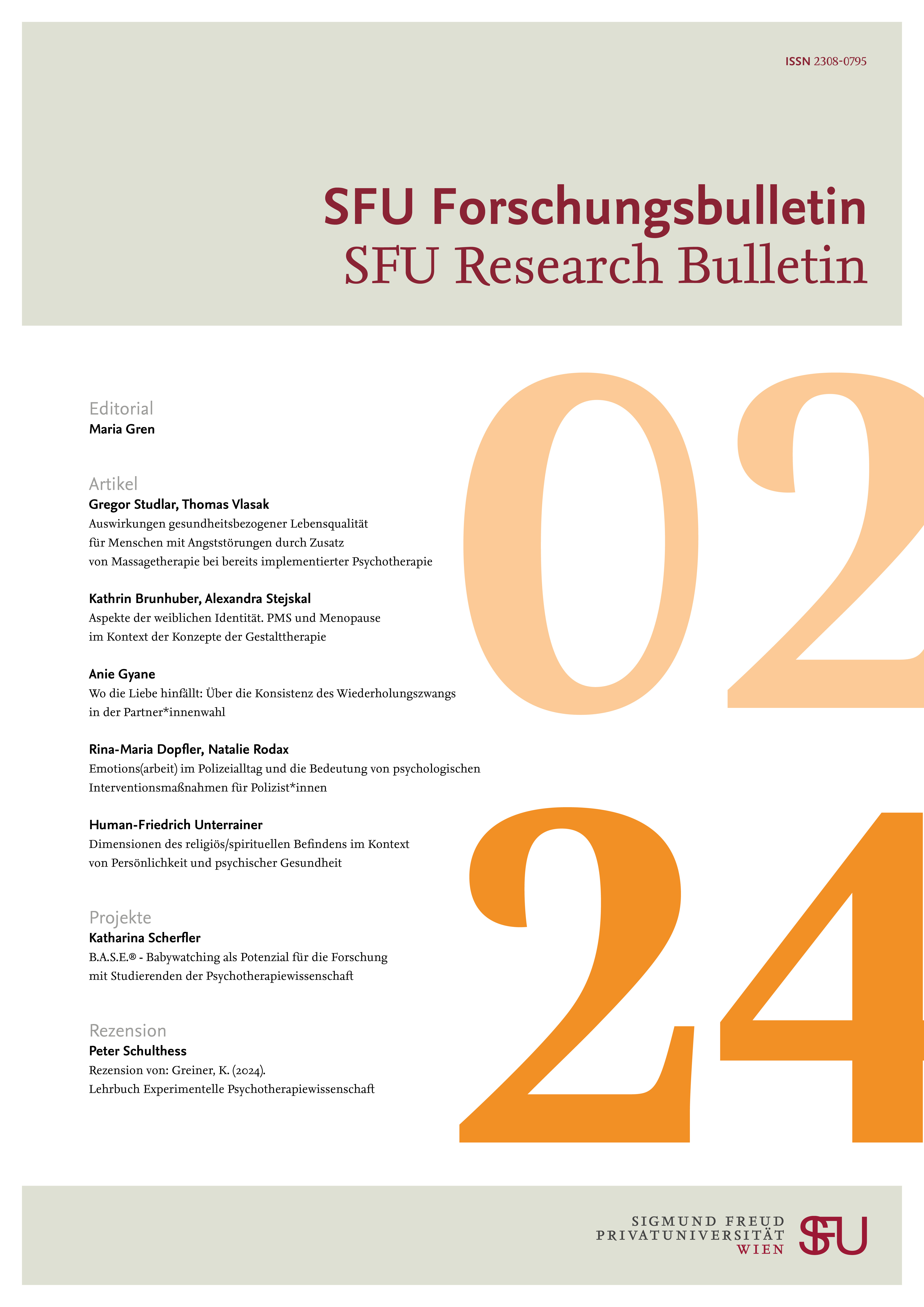Consequences on Health related Quality of Life for People with Anxiety Disorders by supplementing Massage Therapy on already in Existence introduced Psychotherapy
DOI:
https://doi.org/10.15135/2024.12.2.1-15Abstract
In what way can consequences on health related quality of life and clinical anxiety on behalf of the especially vulnerable population group of people with anxiety and panic disorders be measured, by supplementing massage therapy on already in existence introduced psychotherapy with behavior therapy approach. Patients from the psychotherapeutic surgery with the categorial diagnose of panic disorder (n=64), are the base of the study. The test persons did via standardized paper-pencil psychological test procedures (BAI and WHOQOL-BREF), on two test moments (pre-post-test) their statistical tests. Moreover the test persons have been splitted into control- and experimentgroup. Inferential and correlation statistical datas could be examined and in the space of the study documented. So have been demonstrated that within all scales of the psychological test procedures the experimental group – massage and psychotherapy – could transform significantly. The shifts have also been higher than in the control group. At that the higher interdependence on the very vulnerable population group of the people with anxiety disorders and their body-mind-interaction within this study, could be demonstrated and shows the importance for our health care system.
References
Berger, U., Strauß, B. (2019). Prävention. Vierte Säule des Gesundheitssystem. Die Psychotherapie, 64(1), 2–3. DOI: 10.1007/s00278-018-0331-z
Brähler, E., Mühlan, H., Albani, C., Schmidt, S. (2007). Teststatische Prüfung und Normierung der deutschen Versionen des EUROHIS-QOL Lebensqualität Index und des WHO-5 Wohlbefindens-Index. Diagnostica, 53(2). DOI: 10.1026/0012-1924.53.2.83
Daig, I. & Lehmann, A. (2007). Verfahren zur Messung der Lebensqualität. Zeitschrift für medizinische Psychologie, 16(1-2), 5–23.
Deister, A. (1995). Diagnostik und Psychopathologie von Angsterkrankungen. In Siegfrid Kasper, & Hans-Jürgen Müller (Hrsg.), Angst und Panikerkrankungen. Jena: Fischer.
Field, T. (2014). Massage therapy research review. Complementary therapies in Clinical Practice, 20(4), 224–229. DOI: 10.1016/j.ctcp.2014.07.002
Field, T., Ironson, G., Scafidi, F., Nawrocki, T., Goncalves, A., Burgman, I. Pickens, J., Fox, N., Schanberg, S., Kuhn, C. (1996). Massage therapy reduces anxiety and enhances EEG pattern of alertness and math computations. International Journal of Neuroscience. 86(3-4), 179–205. DOI: 10.3109/00207459608986710
Häfner, S. (2005). Psychotherapie und Massage als Zugangswege zum Patienten bei Georg Groddeck. Physikalische Medizin, Rehabilitationsmedizin, Kurortmedizin, 15(1), 39–43. DOI: 10.1055/s-2004-828498
Kahl, K-G., Winter, L., Schweiger, U., Sipos, V. (2011). Die Dritte Welle der Verhaltenstherapie. Eine Übersicht über die Methoden und ihre Evidenzbasierung. Fortschritte der Neurologie – Psychiatrie, 79(6), 330–339. DOI: 10.1055/s-0029-1245963
Kim, E-J., Buschmann, M-T. (1999). The effect of expressive physical touch on patients with dementia. In: International Journal of Nursing Studies, 36(3), 235–243. DOI: 10.1016./s0020-7489(99)00019-x
Kolster, B-C. (2016). Massage. Klassische Massage, Querfriktionen, Funktionsmassage, Faszienbehandlung. 4. Auflage. Berlin: Springer.
Leenen, K., Rufer, M., Moergeli, H., Grabe, H-J., Jenewein, J., Nunez, D-G., Majohr, K-L., Drabe, N. (2015). Alexithyme Patientenmerkmale und Lebensqualität. Eine Querschnittsstudie an 79 ambulanten Patienten mit Angststörungen. Göttingen: Hogrefe. DOI: 10.1024/1661-4747/a000136.
Marks, I. (1993). Ängste. Verstehen und bewältigen. Berlin: Springer.
Metzinger, T. (2007). Grundkurs Philosophie des Geistes. Band 2: Das Leib-Seele-Problem. Paderborn: Mentis.
Moller, J-U. (1994). Psychological aspects of massage. Basic considerations and advanced concepts for physical therapists. Lymphologie, 18(1), 16–19.
Morhenn, V., Beavin, L-E., Zak, P-J. (2012). Massage increases oxytocin and reduces adrenocorticotrophin hormone in humans. Alternative Therapies in Health and Medicine, 18(6), 11–18.
Morschitzky, H. (1998). Angststörungen. Diagnostik, Konzepte, Theorie, Selbsthilfe bei krankhafter Angst. Wien: Springer.
Morschitzky, H. (2009). Angststörungen. Diagnostik, Konzepte, Theorie, Selbsthilfe. Wien: Springer.
Morschitzky, H. (2007). Psychotherapie Ratgeber. Ein Wegweiser zur seelischen Gesundheit. Wien: Springer.
Nowotny, M., Kern, D., Breyer, E., Bengough, T., Griebler, R. (Hg.). (2019). Depressionsbericht Österreich. Eine interdisziplinäre und multiperspektivische Bestandsaufnahme. Wien: Bundesministerium für Arbeit, Soziales, Gesundheit und Konsumentenschutz.
Olatunji, B-O., Cisler, J-M., Tolin, F. (2007). Quality of life in the anxiety disorders: A meta-analytic review. Clinical Psychology Review, 27(5), 572–581. DOI: 10.1016/j.cpr.2007.01.015
Pavot, W., & Diener, E. (1993). Review of the Satisfaction With Life Scale. Psychological Assessment, 5(2), 164–172. DOI: 10.1037/1040-3590.5.2.164
Rapaport, M-H, Schettler, P-J., Bresee, C. (2012). A preliminary study of the effects of repeated massage on hypothalamic-pituitary-adrenal and immune function in healthy individuals: a study of mechanisms of action and dosage. Journal of Alternative Complementary Medicine, 18(8), 789–797.
Reinecker, H. (1993). Phobien. Agoraphobien, soziale und spezifische Ängste. Göttingen: Hogrefe.
Schumacher, J., Klaiberg, A. & Brähler, E. (Hrsg.) (2003). Diagnostische Verfahren zu Lebensqualität und Wohlbefinden. Göttingen: Hogrefe.
Sher, L. (2020). COVID-19, anxiety, sleep disturbances and suicide. Sleep Medicine, Jun(70), 124. DOI: 10.1016/j.sleep.2020.04.019
Zimbardo, P.G. (1995). Psychologie. Berlin: Springer.
Downloads
Published
Issue
Section
License
The reproduction of articles published in any form is allowed under the condition that the citation is comprehensive. Prints in other publication media or public media require the written consent of the editor and can be requested under: forschung@sfu.ac.at
